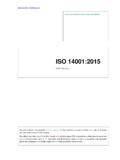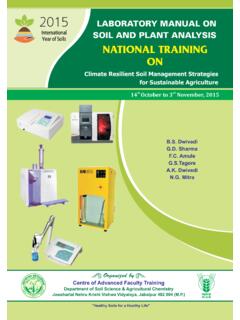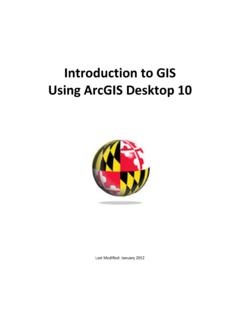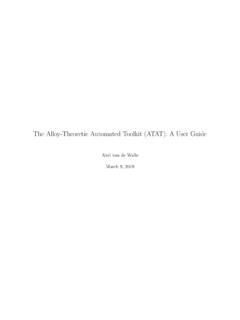Transcription of MODIS Vegetation Index User ’s Guide (MOD13 Series)
1 MODIS Vegetation Index user s Guide (MOD13 Series) Version , June 2015 (Collection 6) Kamel Didan*, Armando Barreto Munoz, Ramon Solano, Alfredo Huete Vegetation Index and Phenology Lab The University of Arizona This is a live document that serves as the user Guide for the MODIS Vegetation Index Product series i Contents 1 Introduction .. 1 The MODIS Vegetation Index (VI) products .. 1 Theoretical Description of Vegetation Indices .. 1 Theoretical basis of the NDVI .. 2 Theoretical basis of the EVI .. 2 EVI backup algorithm .. 3 2 What is new in Collection 5 .. 5 3 File Format of the MODIS VI Products .. 5 4 MODIS VI Product Suite .. 6 5 MOD13Q1/MOD13A1 (16-day 250/500-m) VI .. 6 Algorithm Description .. 7 Scientific Data Sets .. 9 Product Specific Metadata .. 9 Global and Local Metadata Attributes .. 9 Quality Assurance .. 9 QA Metadata .. 10 QA Science Data Sets .. 15 6 MOD13A2 (16-day 1-km) VI.
2 19 Algorithm Description .. 19 Scientific Data Sets .. 19 Product Specific Metadata .. 19 Global and Local Metadata Attributes .. 19 Quality Assurance .. 20 QA Metadata .. 20 QA Science Data Sets .. 20 7 MOD13A3 (monthly 1-km) VI .. 21 Algorithm Description .. 21 Scientific Data Sets .. 22 Product Specific Metadata .. 22 Global and Local Metadata Attributes .. 23 Quality Assurance .. 23 QA Metadata .. 23 QA Science Data Sets .. 23 8 MOD13C1 CMG (16-day ) VI .. 24 Algorithm Description .. 24 ii Scientific Data Sets.. 25 Quality Assurance.. 25 QA Metadata .. 26 QA Science Data Sets .. 26 9 MOD13C2 CMG (monthly ) VI .. 27 Algorithm Description .. 27 Scientific Data Sets .. 27 Quality Assurance .. 28 QA Metadata .. 28 QA Science Data Sets .. 28 10 Related Web Sites.. 28 11 FAQ .. 30 12 Sample images .. 31 1 1 Introduction One of the primary interests of the Earth Observing System (EOS) program is to study the quantity and role of terrestrial Vegetation in large-scale global processes with the goal of understanding how the Earth functions as a system.
3 This requires an understanding of the global distribution of Vegetation types as well as their biophysical and structural properties and spatial/temporal variations. Vegetation Indices (VI) are robust, empirical measures of Vegetation activity at the land surface. They are designed to enhance the Vegetation reflected signal from measured spectral responses by combining two (or more) wavebands, often in the red ( - m) and NIR wavelengths ( m) regions. The MODIS Vegetation Index (VI) products The MODIS VI products (MOD13) provide consistent, spatial and temporal t i m e s e r i e s comparisons of global Vegetation conditions t h a t can be used to monitor the Earth s terrestrial photosynthetic Vegetation activity in support of phenologic, change detection, and biophysical interpretations. Gridded Vegetation Index maps depicting spatial and temporal variations in Vegetation activity are derived at 16-day and monthly intervals i n s u p p o r t o f a c c u r a t e seasonal and inter-annual monitoring of the Earth s terrestrial Vegetation .
4 Two VI products are made globally for land regions. The first product is the standard Normalized Difference Vegetation Index (NDVI), which is referred to as the continuity Index to the existing NOAA-AVHRR derived NDVI. There is currently a ~35-year NDVI global data set (1981 - 2015 ) from the NOAA-AVHRR series, which i n c o n j u n c t i o n with MODIS data provide a long term data record for use in operational monitoring studies. The second VI product is the Enhanced Vegetation Index (EVI), with improved sensitivity over high biomass regions and improved Vegetation monitoring capability through a de-coupling of the canopy background signal and a reduction i n atmosphere influences. The two VIs complement each other in global Vegetation studies and improve upon the extraction of canopy biophysical parameters. To further make these indices more useful a new compositing scheme that reduces angular, sun-target-sensor variations is also utilized.
5 The gridded VI maps use MODIS surface reflectances corrected for molecular scattering, ozone absorption, and aerosols, as input to the VI al go rithm equations. The gridded Vegetation indices include quality assurance (QA) flags with thematic information about the quality of the VI product and input data. The MODIS VI products are currently produced at 250 m, 500 m, 1 km and a s p e c i a l deg. spatial resolutions. For data processing purposes, MODIS VIs are g e n e ra te d in square tile units that are approximately 1200-by-1200 km (at the equator), and mapped in the Sinusoidal (SIN) grid projection (equal area projection). Only tiles containing land features are processed. When mosaicked, all tiles cover the Earth l a n d m a s s and the global MODIS -VI can thus be generated each 16 days and each calendar month. Theoretical Description of Vegetation Indices The theoretical basis for empirical-based Vegetation indices is derived from examination 2 of typical spectral reflectance signatures of leaves.
6 The reflected energy in the visible is very low as a result of high absorption by photosynthetically active pigments, with maxi- mum absorption values in the blue (470 nm) and red (670 nm) wavelengths. Nearly all of the near-infrared radiation (NIR) is scattered (reflected and transmitted) b a c k with very little absorption, in a manner dependent upon the structural properties of a canopy (LAI, leaf angle distribution, leaf morphology). As a result, the contrast between red and near-infrared responses (called the red shift) is a sensitive measure of Vegetation amount, with maximum red NIR differences occurring over a full canopy and minimal contrast over targets with little or no Vegetation . For low and medium amounts of Vegetation , the contrast is a result of both red and NIR changes, while at higher amounts of Vegetation , only the NIR contributes to increasing contrasts as the red band becomes saturated due to chlorophyll absorption.
7 The red-NIR contrast can be quantified through the use of ratios (NIR/red), differences (NIR red), weighted differences (NIR k red), linear band combinations (x1 red+x2 NIR), or hybrid approaches of the above. Vegetation indexes are measures of this contrast and thus are integrative functions of canopy structural (%cover, LAI, LAD) and physiological (pigments, photosynthesis) parameters. T h e o r e t i c a l basis of the NDVI The NDVI is a normalized transform of the NIR to red reflectance ratio, NIR/ red, designed to standardize VI values to between 1 and +1. It is commonly expressed as: dNIRdNIRNDVIReRe (1) As a ratio, the NDVI has the advantage of minimizing certain types of band-correlated noise (positively-correlated) and influences attributed to variations in direct/diffuse irradiance, clouds and cloud shadows, sun and view angles, topography, and atmospheric attenuation. Ratioing can also reduce, to a certain extent, calibration and instrument-related errors.
8 The extent to which ratioing can reduce noise is dependent upon the correlation of noise between red and NIR responses and the degree to which the surface exhibits Lambertian (angle independent) behavior. The main disadvantage of ratio-based indices tend to be their non-linearity exhibiting asymptotic behaviors, which lead to insensitivities to Vegetation variations over certain land cover conditions. Ratios also fail to account for the spectral dependencies of additive atmospheric (path radiance) effects, canopy-background interactions, and canopy bidirectional reflectance anisotropies, particularly those associated with canopy shadowing. T h e o r e t i c a l b a s i s of the EVI To m i n i m i z i n g atmospheric effect t h e difference in blue and red reflectances c a n b e u s e d as an estimator of the atmosphere influence level. This concept is based on the wavelength dependency of aerosol scattering cross sections.
9 In general the scattering 3 cross section in the blue band is larger than that in the red band. When the aerosol concentration is higher, the difference in the two bands becomes larger. This information is used to stabilize the Index value against variations in aerosol concentration levels. The EVI incorporates this atmospheric resistance concept in a similar fashion to the Atmospheric Resistant Index (ARVI), along with the removal of soil-brightness induced variations in VI b as ed on t he Soil Adjusted Vegetation Index (SAVI). The EVI additionally decouples the soil and atmospheric influences from the Vegetation signal by including a feedback term for simultaneous correction. The EVI formula is written as: LBlueCdCNIRdNIRGEVI 2Re1Re (2) where NIR, Red, and Blue are the full or partially atmospheric-corrected (for Rayleigh scattering and ozone absorption) surface reflectances; L is the canopy background adjustment for correcting the nonlinear, differential NIR and red radiant transfer through a canopy; C1 and C2 are the coefficients of the aerosol resistance term (which uses the blue band to correct for aerosol influences in the red band); and G is a gain or scaling factor.
10 The coefficients adopted for the MODIS EVI algorithm are, L=1, C1=6, C2= , and G= EVI backup algorithm Per Figure 1, EVI exhibits erratic behavior over bright targets (heavy clouds, and snow/ice). This is mostly due to the inability of the blue band (saturates) to convey any useful atmosphere information which inhibits the EVI formulation leading to extremely high EVI values over bright targets. To address this issue starting Collection the s t a n d a rd 3-band EVI is replaced by a modified 2-band EVI (does not use the blue band) over high-reflectance surfaces such as clouds and snow/ice. This situation i s f u r t h e r exacerbated by an imperfect atmospheric correction procedure that further promotes a nom alo us EVI values. Because the 2-band EVI does not use the blue band, it becomes insensitive to these effects, while maintaining the other advantages of the EVI (Fig. 2). The 2-band EVI equation used for the MODIS VI products is: dNIRdNIREVI (3) 4 Figure 1: (a).






